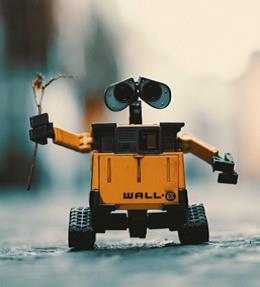
Written by Vaibhav Shah
If you are a fan of science fic movies just like me, I guess Artificial Intelligence is something that would pique your fascination. Take the example of JARVIS from Marvel's franchise Ironman. The smart AI system who manages everything for the protagonist - Tony Stark. From assisting him when he’s out to save the world to operating his suite (and even optimizing the temperature of his mansion). Amusing, right? Yes of course!
But what’s even more fascinating is that this kind of technology is no longer limited to a movie screen. It has become an utter reality and has blended into our daily lives. Although today's AI are not as sophisticated as JARVIS they are indeed helping to make our cement-and-mota-homes smarter. In this article, we’ll discuss how exactly AI has become part of homes, what benefits it caters and what are concerns it brings. But first...
What Is Artificial Intelligence?
Artificial intelligence refers to software or hardware that replicates human intelligence and behavior such as learning, reasoning, problem solving and correction. There is a number of examples of AI performing tasks that need human intelligence such as driving a car, teaching a language or translate it, scheduling a meeting and organize your documents.
Artificial Intelligence can be divided into two categories on the basis of their level of intelligence, namely - Narrow/Weak AI and Strong AI. Narrow AI are software and systems that can perform only a narrow purview of tasks they are designed for. While strong AI is the system that can perform unfamiliar tasks beyond the domain of their knowledge and that too without any human assistance.
In the last few years, artificial intelligence has brought promising change to our life - whether it be enhancing our productivity at work or making our daily chores easy. From smart replies in Gmail to the AI-driven mobile apps we use daily; from autonomous driving cars to eliminating dangerous tasks at the workplace - AI is all-over and gradually it is becoming an integral part of our homes too.
Artificial Intelligence In Our Homes
Research by Statista shows that smart homes are on the rise and more the 45 million home devices were installed in 2018, which makes the annual growth rate of the home automation 22%. Further, a report by Cisco states that the smart home industry makes 20% of the total predicted M2M connection that includes connected devices for home automation, security and surveillance and other devices. Even gadgets like Google Home and Amazon Echo are making it possible to connect different home devices to the internet and operate them with voice commands. All this might sound quite sophisticated but Artificial Intelligence is taking it even a step further.
AI technologies such as machine learning, machine vision and robotics are making our smart homes even smarter. Here are a few examples of how these technologies are contributing to it.
Machine Learning & Automation

Machine learning refers to the process in which machines and devices analyse the data, learns from it and act without any need for programming. The more data the machines learn the smarter it gets.
In homes, it can be used to understand the owner’s behaviour patterns and automate the tasks. Let me give you an example - the homeowner likes to listen to jazz in the morning, so AI will play the same followed by the alarm. When he/she gets back home from the office, it will turn on the light and optimize the temperature. If the owner cooks a particular stew every weekend, it will learn from the past pattern and adjust the flames automatically.
Machine learning identifies the data patterns of events to automate them. If one event occurs - wake up alarm, another event must be followed - turning on Jazz music.
Machine Vision & Face Recognition
Machine Vision is a machine-based image processing that works like human eyes. It enables the devices to see with the help of the camera and analyze the information for processing. This can take home security and surveillance to a whole new level.
For instance, AI-based cameras can identify faces with facial landmarks and recognize the individuals from the data provided. So the owner can directly be notified about who visited the home whether it was a relative, friend or guest. This provides convenience with a high level of accuracy. Many advanced home security systems already use this technology to identify faces through facial landmarks such as nose, eyes, lips, cheekbones, etc.
Robotics
AI robots can be said to be one of the greatest achievements of modern science. They are capable of performing human tasks with better efficiency and accuracy. Many repetitive and dangerous tasks such as car manufacturing, industrial welding, deepwater exploration, etc are now automated with AI robots. But this is not limited to industries. There are many robots engineered to help us with daily household chores too.
A few popular examples are robot vacuum cleaners, window cleaners, autonomous lawn rover and swimming pool cleaner. Companies like Dyson and Roomba has revolutionized the floor cleaning process with their AI autonomous vacuum cleaner. These robots are capable to navigate themselves through the house utilizing the machine vision without bumping with any obstacles. This makes the boring task of cleaning the house autonomous without any human intervention.
All these alludes to one thing- artificial intelligence integrating with anything gives it a human-like intelligence and provides us with better productivity and convenience. Our homes are no exception. However, this amazing technology is not a silver bullet as it comes with some concerns and flaws.
Concerns that AI Brings
The sophistication and convenience that AI brings with it have also sparked the debate of privacy and security. AI and machine learning need to learn from the patterns and data to serve you better. Further, these data gathered from devices is stored somewhere (either on the cloud or private server) that breeds the vulnerability of hacking and trespassing your sensitive information. This might be the only limitation apart from the costs that seem to crumble the dream of having a JARVIS like smart AI in our homes. However, at present, the benefits against the flaws seem to weigh more and even there are people making constant endeavors to overcome the flaws and step into the future of AI in our homes.



